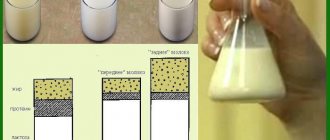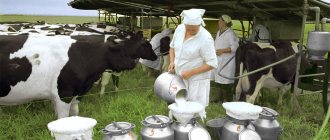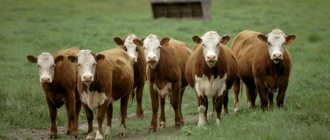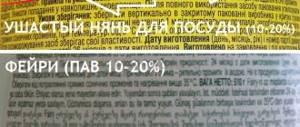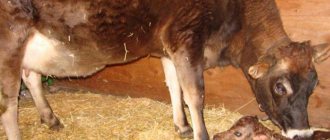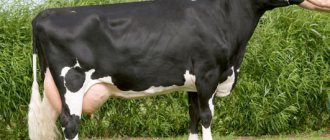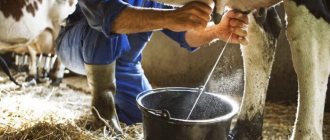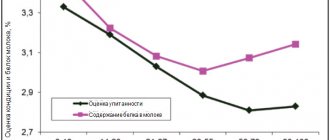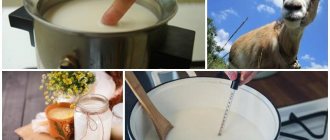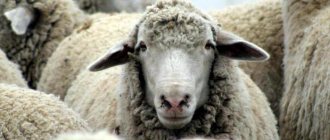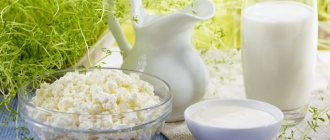Dairy farming is one of the profitable industries in agriculture. Products obtained from cows are not only tasty, but also healthy. However, few people know how many beneficial substances actually are included in milk and what to do to ensure that the fat content is at the desired level. We hope our article will help you figure this out.
The fat content of a cow's milk is one of the main indicators of the quality of this product. It’s not without reason that milk packages focus buyers’ attention on fats, proudly “protruding” this indicator on a unit of dairy product.
Some people buy pasteurized store-bought milk, while other consumers prefer a natural product from the owners. However, such ideas are just the tip of the iceberg - to learn more about milk, you need to become more familiar with the fat content and know what it depends on and how it is increased.
Fat content
The norm for the fat content of milk in a cow is 3.4%. A higher percentage allows you to increase the cost of production. Farms work to maintain this important indicator not lower than the stated norm; factories also control the quality of raw materials: the fat content and quality of cheeses, butter, and sour cream will depend on the chemical content that is included in milk.
Based on accepted standards, the acceptable fat content of domestic cow's milk is 3.3−6%. As for the product in its natural form, the latter figure of more than 6-8% may indicate the presence of vegetable fats in it.
Concept and meaning
Milk fat refers to the fat globules found in the milk of farm animals. It is a product with a high level of saturated acid capacity.
If a cow produces a small amount of milk, then its fat content is high. Otherwise, the cow can only boast of a large milk yield, but small percentages of nutrients.
There are two types of indicators. Take a package and you will see the relative percentage of fat content of cow's milk in one liter. It is used most often when assessing the quality of a product. This % is higher when the cow is characterized by low productivity.
The Jersey cow has the highest numbers - the relative fat content reaches 14%. The milk yield of this breed is small, and the total amount of fat during the entire lactation period does not exceed 700 kg.
Factors influencing fat content
The main condition for obtaining high-quality milk is the breed of the cow. For example, representatives of the Holstein can produce up to a ton of product with a density in the range of 3.3−3.8%.
The fattest dairy product is produced by Kyrgyz, Caucasian and some other breeds. The most delicious and high-quality butter is obtained from the production of cows of the Kostroma and Krasnogorbatovskaya branches.
The fat content of cow's milk in percentage varies depending on the time of year, the condition of the animal, heredity, time of day, age, diet and conditions of detention. The maximum level of this indicator will be different in summer and winter.
How to increase the fat content of a cow's milk
You can increase the level of fat in a product in order to make it even more tasty and nutritious, as well as to increase its selling price.
Secrets to increasing your score:
- Diet. An increase in fat can be noted when feeding the animal fresh green grass. In summer, if possible, the cow should be grazed on pasture.
- Udder massage. It must be carried out before each milking. This procedure will stimulate the secretion of stagnant milk, which contains the highest fat level.
- Milking “foremilk”. Typically, milk obtained in the first seconds of milking has less fat.
- If you milk it into a separate container, the amount of fat in the subsequent product will automatically increase. In addition, this trick will increase the hygiene of the process. The animal must be carefully “milked” to the last drops.
It is in residual milk that the fat level is highest.
To increase the fat content of milk it is recommended:
- Form a basic diet of roughage and succulent feed, rich in sugar, fiber and starch - carbohydrates that play a key role in the formation of milk fat;
- Introduce sodium acetate into the intestines (150-300 g per day), which increases the content of acetic acid - the material for the formation of fat cells;
- During the stall period, add sugar beets to the food (about 2 kg per 1 liter of milk) or similar products with a large amount of “fast” carbohydrates, which increases the fat content by up to 0.5%;
- Short-term addition of brewer's yeast (3 kg for 3 days) increases fat content by 0.2-.03% for one and a half months;
- Feeding with iodized salt to stimulate the thyroid gland.
The fat content of milk may vary depending on the supplier and time of year. As for milk for making yogurt, its fat content is determined by the taste preferences of consumers and is established in accordance with the regulations of certain countries. In this regard, the normalization of milk by fat content is a fairly significant factor.
Theoretically, the process of milk normalization can be represented as follows:
The correctness of the normalization process depends on:
- type of equipment used and separation efficiency;
- the monitoring and control system used.
The efficiency of such normalization with the equipment that has appeared recently has increased significantly, so that the fat content in skim milk is usually reduced to 0.05-0.07 g/100 g of milk. Accordingly, the separation efficiency for separators is considered to be 0.05–0.07. The control system used on milk normalization lines can be either automated or manually controlled, and if the latter can be recommended for small medium-sized production, then automated systems are more suitable for enterprises that process significant volumes of milk per day.
A large number of systems can be used to normalize milk. The effectiveness of any particular product depends on the extent to which it can ensure that the following conditions are met: • the pressure of the skim milk at the outlet is lower than the pressure in the tank where the cream is mixed with the skim milk; • the fat content of the cream remained constant, the proportions were maintained when mixing cream with skim milk, that is, there should be control over the mixing proportions; • the final fat content of processed milk remained within the established limits.
The possibility of using such systems for the production of yoghurt can be considered under the following conditions: a) if the DM content of milk is increased using an evaporator (see Fig. 3.13 and 3.17), then it is necessary to normalize the milk before the thickening process begins; b) if the skim milk can be thickened by evaporation and then the concentrated skim milk can be normalized with cream before subsequent processing (eg homogenization and heat treatment); c) if concentrated skim milk can be normalized with cream; and d) if membrane filtration (ultrafiltration or reverse osmosis) is occasionally used to thicken the milk base. Typically, whole milk is separated, skim milk is condensed to the desired DM content, and then normalized with cream.
In general, the milk base is normalized for fat content before evaporation begins. However, if skim milk is UV-condensed, cream is added later. This is due to the high pressure used during thickening, which can lead to changes in some of the physical properties of the fat, which in turn can affect the quality of yoghurts (for example, the effect of fat separation or churning).
How to determine fat content at home
It is not easy to accurately determine the fat content of milk without equipment. You can only get an approximate figure at home yourself.
To determine the amount of fat, carry out the following steps: Take a transparent glass, wash it well and dry it. Set the line at 10 cm. Pour in fresh milk and leave for 8 hours in a warm room;
After time, use a ruler to measure the layer of cream that appears on top. Now you need to calculate one indicator.
10 cm is taken as 100% fat content. Now you can calculate the amount of fat in your milk. However, it is important to remember that this result is not 100% accurate.
How to skim milk at home using a cold method?
This is the simplest and oldest home method for skimming milk. This is exactly how cream was once skimmed from milk, when separators had not yet been invented.
Option number 1. This option is suitable if you have a lot of milk. Pour whole milk into a container of suitable size, place in the refrigerator and leave for at least 10-12 hours. During this time, the milk will be divided into 2 fractions - liquid and fat.
Now place the container with milk on the table, place a stool below and place a container on it to drain the skim milk. Take a clean rubber tube about 70-80 cm long and immerse one end of it at the very bottom of a can of milk, and place the other in a still empty container for skim milk.
Remove the air from the tube by hand or otherwise, and the skim milk will flow into the container on the stool. Watch the process carefully: the cream will gradually sink to the bottom of the container, and you must have time to remove the tube before the cream gets into the second container.
Delicious recipe! Pizza preparation method with sausage and cheese
Option number 2. This option is useful if there is only a couple of liters of milk. All you need to do is pour fresh homemade milk into a wide-necked container or, say, a bowl, and then put it in the refrigerator for 10-12 hours. During this time, natural separation will occur and the fat fraction, i.e. cream, will separate from the milk and float to the surface. Now you can easily skim the cream from the milk using a regular clean spoon.
Conditions of detention and milk fat content
The fat content of milk is influenced by all factors important for the healthy development of the animal:
- Optimal temperature conditions;
- Healthy humidity and ventilation;
- Frequent milking intervals.
Long daily walks in cold weather and grazing in summer make it possible to achieve an optimal and stable level of milk fat content for a particular cow.
In hot weather, the quality of milk decreases, in cold weather it increases. The best performance is achieved at a temperature of 10-16 degrees.
The last portions of milk are always the fattest. Frequent milking with additional “massage” irritation of the udder ensures the most complete removal of milk from the udder, and therefore its best fat content
Contraindications
Lactose is not fully absorbed by every body, and its individual intolerance becomes a contraindication to drinking cow's milk.
Lactose favors the formation of a putrefactive environment and sometimes causes digestive problems. The chemical composition of milk becomes depleted when boiled, but in its fresh form it is contraindicated for infants due to contamination with bacteria.
Milk is contraindicated for people with salt deposits in blood vessels
For diseases of the gastrointestinal tract, liver, and pancreas, it is worth replacing the consumption of fresh products with fermented milk.
Types of fat content
The assessment of the quality of natural milk is determined by the milk fat content, which is measured as a percentage.
Today, there are several types of this product, which are divided depending on the percentage of fat in its composition.
This indicator is significant for different foods, as well as other areas of use. Did you know? If it is not possible to purchase cow's milk of a certain fat content, you can take goat's milk.
It has an indicator of 4 to 9%, in addition, it contains the same amount of useful elements and is digested in the same way as cow's milk.
Categories
- up to 1% - low-fat, drunk by people who avoid fatty foods;
- up to 2% - a low percentage, but the most popular product used in various fields; 3.5% is the average norm when determining the indicator of a paired product immediately after milking;
- from 4.5 to 6% - high fat content, which is produced only by certain breeds of cows;
- 10% - maximum fat content, presented in the form of cream.
The fat content of cow's milk is a distinctive feature of this product, for which it is valued by the consumer. Increasing the fat content of homemade milk is not so difficult; it is much more difficult to properly care for the animal in order to prolong maximum lactation and constantly receive a high-quality fatty product.
How to skim milk by settling
The settling method is the method that is used most often. It makes it possible to remove the cream from the milk, after which it becomes less fatty.
Delicious recipe! I eat a lot of black bread
The procedure looks like this:
- Fresh milk should be poured into a saucepan or large bowl (this will make skimming the cream easier).
- Place the container in the refrigerator overnight. In 10–12 hours, the cream will separate from the milk mixture naturally.
- Take a clean spoon and carefully skim off all the cream. They are suitable for consumption.
The milk that remains in the pan will be low-fat. It needs to be poured into a clean jar and stored in the refrigerator.
